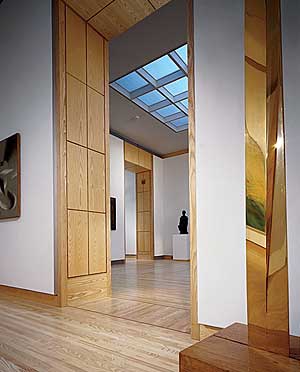Making new demands
It’s important to understand that this kind of sophisticated climate control was still fairly new at the time Otto was designed. Art conservators were making demands that neither the world of architects nor the world of engineers and contractors had quite caught up with.
Okay, that’s the art guys’ story. The weather guys—the architect, his engineering consultants, and the builder—created pretty much the kind of wall they’d always built. Its primary purpose was not to nurture the art but to keep out the weather. They built a cavity wall, a sandwich of materials including a vapor barrier. They finished Otto’s exterior in porcelain enamel panels, thin limestone panels, and glass windows. They finished the interior in ordinary drywall.

Several things went wrong:
The pressurized interior air naturally tended to leak out through the wall. You can think of the building as a big machine for the purpose of pumping moist indoor air into the cavity. When it got there in winter months, of course it condensed. The condensation sometimes froze. The wall began to rust and rot. There were times when it was soaked through.
Most of the people I talked to blame the vapor barrier. They say it was mislocated, or that it failed. Architect Charles Gwathmey is one. He believes his wall design was not to blame and suggests other possibilities. “Somebody must have cut holes in the vapor barrier after it was installed,” Gwathmey says. “Maybe a subcontractor installing plumbing or telephone connections.”
Vapor barriers do, in fact, get punctured. Andy Sebor is a Connecticut mechanical engineer who is a recognized expert in this field. He says failures of this kind are common in art museums of Otto’s vintage. He notes that at the Davis Museum at Wellesley, a building by another Pritzker-winning architect, Rafael Moneo, the curators themselves caused problems. They ruptured the vapor barrier by drilling holes to hang artworks.
“You have to keep the vapor barrier away from the owner’s drill bit,” says Sebor wryly.
Sebor says that both construction methods and curatorial demands were changing in the years leading up to the Otto. “We engineers let architects and curators go off on their own,” he says. “There was a lot of wishful thinking.” Architects today, says Sebor, are more sophisticated, especially in cold climates.
The role of a barrier
But all the talk about vapor barriers misses some of the point. The purpose of a vapor barrier, pace Gwathmey, is not to prevent moist air from penetrating the wall. It is to prevent water molecules in that air—not the air itself—from diffusing through the barrier. It doesn’t matter if there are a few holes. The barrier will still retard molecular diffusion.
The bigger problem comes when the moist air itself penetrates the cavity. Besides the vapor barrier, which usually won’t prevent that, there must be an air barrier, which must have no leaks and must be strong enough not to be ruptured. The two barriers can be combined into one, or they can be separate.
I realize that many record readers are going to know more than I do about this problem, so I’ll merely recommend the best source I found. This is an article, “Condensation in the Building Envelope,” by Vincent Cammalleri of the engineering firm Simpson Gumpertz & Heger (SGH). It’s on the AIA Web site: http://www.aia.org/SiteObjects/files/bsci_cammalleri.pdf. SGH won’t name its clients, but clearly the firm is seldom lacking in museums that need help.
There are a couple of other lessons to be learned from Otto. One is that long-term institutions like Harvard should build durably, as they did in the past. They’re short-sighted when they indulge in the cost-cutting that’s common in the commercial world. At Otto, the exterior metal panels were connected to the framing structure by galvanized ties, which quickly rusted from the moisture. They should have been stainless steel.
Another lesson is always to ask where standards come from. Indoor humidity of 50 per cent is an arbitrary number, one that may not be right for cold climates like that of Cambridge, with its frequent freeze-thaw cycles.
Finally, of course, the art guys and the weather guys should be sure they’re on the same page, that neither is doing something that will sabotage the work of the other.
Otto’s health was never restored. Nothing worked quite right. The interior never made it up to the desired 50 percent humidity because of the leakage. Even the windows didn’t work. They lacked thermal breaks, meaning they, too, could become sources of condensation. (That problem was Band-Aided with heated electrical tape.)
Harvard sued the architect and the contractor in 1996. As usual in such legal matters, neither side will talk for the record. But word on the street is that the parties split the cost of repairs—repairs that proved, in the end, not to make any difference.




Post a comment to this article
Report Abusive Comment